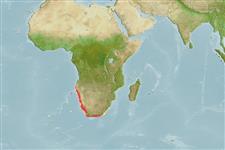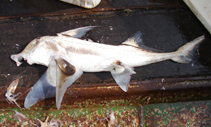Callorhinchus capensis Duméril, 1865
Cape elephantfish
Adicionar sua observação em Fish Watcher
| Native range | All suitable habitat | Point map | Year 2050 |

|
| This map was computer-generated and has not yet been reviewed. |
| Callorhinchus capensis AquaMaps Data sources: GBIF OBIS |
Carregue seu(sua) Fotos e vídeos
Pictures | Imagem do GoogleCallorhinchus capensis
Picture by Le Noury, P.
Pictures | Imagem do GoogleCallorhinchus capensis
Picture by Le Noury, P.
South Africa country information
Common names:
Elephantfish, Josef
Occurrence: native
Salinity: marine
Abundance: | Ref:
Importance: minor commercial | Ref: Compagno, L.J.V., 1986
Aquaculture: | Ref:
Regulations: no regulations | Ref: van der Elst, R., 1993
Uses: live export: yes;
Comments: Abundant off the west coast and the southeastern Cape but uncommon off Natal. Target species of a gillnet fishery operating in St. Helena Bay. Marketed locally. Angling record: 6 kg; spearfishing record: 3.6 kg (Ref. 12484). Also Ref. 3180, 27363, 58304.
National Checklist:
Country Information: https://www.cia.gov/library/publications/resources/the-world-factbook/geos/sf.html
National Fisheries Authority:
Occurrences: Occurrences Point map
Main Ref: Compagno, L.J.V., D.A. Ebert and M.J. Smale, 1989
National Database:
Occurrence: native
Salinity: marine
Abundance: | Ref:
Importance: minor commercial | Ref: Compagno, L.J.V., 1986
Aquaculture: | Ref:
Regulations: no regulations | Ref: van der Elst, R., 1993
Uses: live export: yes;
Comments: Abundant off the west coast and the southeastern Cape but uncommon off Natal. Target species of a gillnet fishery operating in St. Helena Bay. Marketed locally. Angling record: 6 kg; spearfishing record: 3.6 kg (Ref. 12484). Also Ref. 3180, 27363, 58304.
National Checklist:
Country Information: https://www.cia.gov/library/publications/resources/the-world-factbook/geos/sf.html
National Fisheries Authority:
Occurrences: Occurrences Point map
Main Ref: Compagno, L.J.V., D.A. Ebert and M.J. Smale, 1989
National Database:
Common names from other countries
Classificação / Names Nomes comuns | Sinônimos | Catalog of Fishes(Gênero, Espécies) | ITIS | CoL | WoRMS | Cloffa
Holocephali (quimeras) (chimaeras) > Chimaeriformes (Chimaeras) > Callorhinchidae (Plownose chimaeras)
Etymology: Callorhinchus: Tautonymous with Chimaera callorynchus Linnaeus 1758 (but unnecessarily emended from -rynchus to -rhinchus: callum (L.), hard skin; rhynchus (L.), snout, referring to peculiar hoe-shaped proboscis (See ETYFish); capensis: -ensis, Latin suffix denoting place: Cape of Good Hope, type locality (See ETYFish).
More on author: Duméril.
Etymology: Callorhinchus: Tautonymous with Chimaera callorynchus Linnaeus 1758 (but unnecessarily emended from -rynchus to -rhinchus: callum (L.), hard skin; rhynchus (L.), snout, referring to peculiar hoe-shaped proboscis (See ETYFish); capensis: -ensis, Latin suffix denoting place: Cape of Good Hope, type locality (See ETYFish).
More on author: Duméril.
Issue
Needs revision.
Environment: milieu / climate zone / depth range / distribution range Ecologia
marinhas demersal; intervalo de profundidade 10 - 374 m (Ref. 5578), usually 10 - 200 m (Ref. 3180). Subtropical; 17°S - 35°S, 11°E - 34°E
Distribuição Países | Áreas da FAO | Ecossistemas | Ocorrências | Point map | Introduções | Faunafri
Comprimento de primeira maturação / Tamanho / Peso / Idade
Maturity: Lm 49.6 range ? - ? cm
Max length : 122 cm TL macho/indeterminado; (Ref. 3180); peso máx. publicado: 5.3 kg (Ref. 40637)
Max length : 122 cm TL macho/indeterminado; (Ref. 3180); peso máx. publicado: 5.3 kg (Ref. 40637)
Descrição suscinta Chaves de identificação | Morfologia | Morfometria
Espinhos dorsais (total) : 1. An elephant fish with a hoe-like snout and arched caudal fin (Ref. 5578). Silvery or bronzy with brown markings on flanks and head; fin webs brown (Ref. 5578).
Found from close inshore and shallow bays to the slope (Ref. 5578). Feeds on small fish and a wide variety of invertebrates (Ref. 27121). Oviparous (Ref. 50449). Produces egg-cases that are spindle shaped, with broad horizontal flanges (Ref. 36731). This species is known to host on its gills monogenean parasites Callorhynchocotyle callorhynchi (Manter, 1955) (Hexabothriidae) and Callorhynchicola multitesticulatus Manter, 1955 (Chimaericolidae) on its gills (Ref. 124045, 124046). Sold commercially as 'silver trumpeter' (Ref. 3180) and considered a delicacy in southern Africa (Ref. 27121). Minimum depth reported from Ref. 7403.
Ciclo de vida ou comportamento de acasalamento Maturidade | Reprodução | Desova | Ovos | Fecundidade | Larvas
Oviparous (Ref. 50449).
Referência principal
Upload your references | Referências | Coordenador | Colaboradores
Krefft, G., 1990. Callorynchidae. p. 117. In J.C. Quero, J.C. Hureau, C. Karrer, A. Post and L. Saldanha (eds.) Check-list of the fishes of the eastern tropical Atlantic (CLOFETA). JNICT, Lisbon; SEI, Paris; and UNESCO, Parisl. Vol. 1. (Ref. 7403)
Status na Lista Vermelha da UICN (Ref. 130435: Version 2024-2)
Segura ou pouco preocupante (LC) ; Date assessed: 02 September 2019
Uso pelos humanos
Pescarias: pouco comercial; peixe esportivo: sim
FAO(pescarias: produção; publication : search) | FIRMS (Stock assessments) | FishSource | Sea Around Us
Mais informação
Population dynamics
Parâmetros de crescimento
Max. ages / sizes
Length-weight rel.
Length-length rel.
Frequências de comprimento
Conversão de massa
Recrutamento
Abundância
Parâmetros de crescimento
Max. ages / sizes
Length-weight rel.
Length-length rel.
Frequências de comprimento
Conversão de massa
Recrutamento
Abundância
Life cycle
Reprodução
Maturidade
Fecundidade
Desova
Spawning aggregations
Ovos
Desenvolvimento dos ovos
Larvas
Dinâmica larval
Reprodução
Maturidade
Fecundidade
Desova
Spawning aggregations
Ovos
Desenvolvimento dos ovos
Larvas
Dinâmica larval
Anatomy
Área branquial
Brain
Otolith
Área branquial
Brain
Otolith
Physiology
Body composition
Nutrients
Consumo de oxigênio
Tipo de natação
Velocidade de natação
Visual pigments
Fish sound
Diseases & Parasites
Toxicity (LC50s)
Body composition
Nutrients
Consumo de oxigênio
Tipo de natação
Velocidade de natação
Visual pigments
Fish sound
Diseases & Parasites
Toxicity (LC50s)
Genetics
Genética
Heterozygosity
Hereditariedade
Genética
Heterozygosity
Hereditariedade
Human related
Aquaculture systems
Perfis para aquacultura
Estirpes
Ciguatera cases
Stamps, coins, misc.
Aquaculture systems
Perfis para aquacultura
Estirpes
Ciguatera cases
Stamps, coins, misc.
Ferramentas
Livro eletrônico | Guia de campo | Ferramenta auxiliar de frequências de comprimento | Ferramenta sobre a história de vida | Mapa de pontos | Classification Tree
| Catch-MSY |
Relatórios especiais
Checar Manutenção em Aquário | Checar Planilhas de Fatos sobre as Espécies | Checar Planilhas de Fatos sobre Aquicultura
Baixar XML
Fontes da internet
Aquatic Commons | BHL | Cloffa | Websites from users | Checar Observador de Peixes (FishWatcher) | CISTI | Catalog of Fishes(Gênero, Espécies) | DiscoverLife | ECOTOX | Faunafri | Fishtrace | GenBank(genoma, nucleotídeo) | GloBI | GOBASE | | Google Books | Google Scholar | Google | IGFA World Record | MitoFish | Otolith Atlas of Taiwan Fishes | PubMed | Reef Life Survey | Scirus | SeaLifeBase | Árvore da vida | Wikipedia(Ir para, procura) | World Records Freshwater Fishing | Registro zoológico
Estimates based on models
Preferred temperature (Ref. 115969): 10.3 - 21, mean 16.2 (based on 200 cells).
Índice de diversidade filogenética (Ref. 82804): PD50 = 0.7500 [Uniqueness, from 0.5 = low to 2.0 = high].
Bayesian length-weight: a=0.00389 (0.00180 - 0.00842), b=3.12 (2.94 - 3.30), in cm Total Length, based on all LWR estimates for this body shape (Ref. 93245).
Nível Trófico (Ref. 69278): 3.5 ±0.52 se; based on food items.
Resiliência (Ref. 120179): Baixo, tempo mínimo de duplicação da população 4,5 - 14 anos (Fec assumed to be <100).
Fishing Vulnerability (Ref. 59153): High vulnerability (59 of 100).
Climate Vulnerability (Ref. 125649): Moderate to high vulnerability (50 of 100).




